Question 1
Refer to the exhibit.
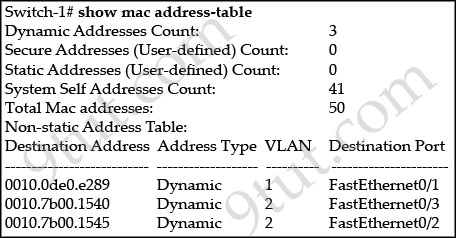
Switch-1 needs to send data to a host with a MAC address of 00b0.d056.efa4. What will Switch-1 do with this data?
A. Switch-1 will drop the data because it does not have an entry for that MAC address.
B. Switch-1 will forward the data to its default gateway.
C. Switch-1 will flood the data out all of its ports except the port from which the data originated.
D. Switch-1 will send an ARP request out all its ports except the port from which the data originated.
Answer: C
Explanation
The MAC address of 00b0.d056.efa4 has not been learned in its MAC address table so Switch-1 will broadcast the frame out all of its ports except the port from which the data originated.
Question 2
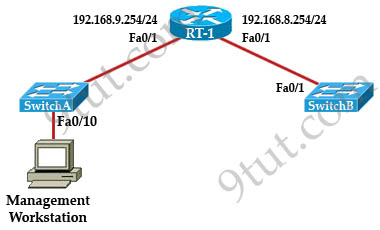
A technician has installed SwitchB and needs to configure it for remote access from the management workstation connected SwitchA. Which set of commands is required to accomplish this task?
A.
SwitchB(config)#interface FastEthernet 0/1
SwitchB(config)#ip address 192.168.8.252 255.255.255.0
SwitchB(config)#no shutdown
B.
SwitchB(config)#ip default-gateway 192.168.8.254
SwitchB(config)#interface vlan 1
SwitchB(config)#ip address 192.168.8.252 255.255.255.0
SwitchB(config)#no shutdown
C.
SwitchB(config)#interface vlan 1
SwitchB(config)#ip address 192.168.8.252 255.255.255.0
SwitchB(config)#ip default-gateway 192.168.8.254 255.255.255.0
SwitchB(config)#no shutdown
D.
SwitchB(config)#ip default-network 192.168.8.254
SwitchB(config)#interface vlan 1
SwitchB(config)#ip address 192.168.8.252 255.255.255.0
SwitchB(config)#no shutdown
Answer: B
Explanation
To remote access to SwitchB, it must have a management IP address on a VLAN on that switch. Traditionally, we often use VLAN 1 as the management VLAN (but in fact it is not secure).
In the exhibit, we can recognize that the Management Workstation is in a different subnet from the SwitchB. For intersubnetwork communication to occur, you must configure at least one default gateway. This default gateway is used to forward traffic originating from the switch only, not to forward traffic sent by devices connected to the switch.
Question 3
A switch is configured with all ports assigned to vlan 2 with full duplex FastEthernet to segment existing departmental traffic. What is the effect of adding switch ports to a new VLAN on the switch?
A. More collision domains will be created.
B. IP address utilization will be more efficient.
C. More bandwidth will be required than was needed previously.
D. An additional broadcast domain will be created.
Answer: D
Question 4
Refer to the exhibit. The two connected ports on the switch are not turning orange or green. What would be the most effective steps to troubleshoot this physical layer problem? (Choose three)
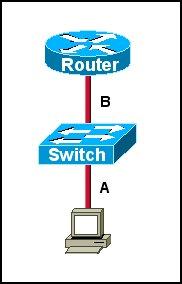
A. Ensure that the Ethernet encapsulations match on the interconnected router and switch ports.
B. Ensure that cables A and B are straight-through cables.
C. Ensure cable A is plugged into a trunk port.
D. Ensure the switch has power.
E. Reboot all of the devices.
F. Reseat all cables.
Answer: B D F
Explanation
The ports on the switch are not up indicating it is a layer 1 (physical) problem so we should check cable type, power and how they are plugged in.
Question 5
Refer to the exhibit.
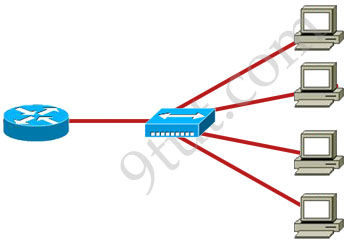
What two results would occur if the hub were to be replaced with a switch that is configured with one Ethernet VLAN? (Choose two)
A. The number of collision domains would remain the same.
B. The number of collision domains would decrease.
C. The number of collision domains would increase.
D. The number of broadcast domains would remain the same.
E. The number of broadcast domains would decrease.
F. The number of broadcast domains would increase.
Answer: C D
Question 6
Refer to the exhibit. Give this output for SwitchC, what should the network administrator’s next action be?
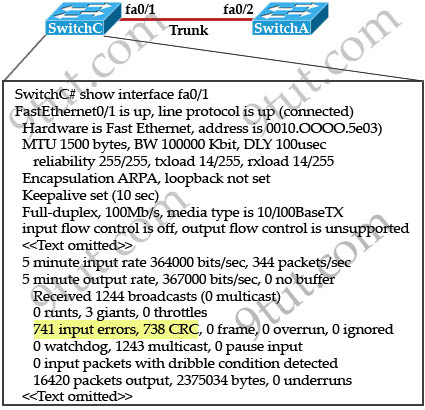
A. Check the trunk encapsulation mode for SwitchC’s fa0/1 port.
B. Check the duplex mode for SwitchC’s fa0/1 port.
C. Check the duplex mode for SwitchA’s fa0/2 port.
D. Check the trunk encapsulation mode for SwitchA’s fa0/2 port.
Answer: C
Question 7
Which three statements accurately describe layer 2 Ethernet switches? (choose three)
A. Microsegmentation decreases the number of collisions on the network.
B. If a switch receives a frame for an unknown destination.it uses ARP to resolve the address.
C. Spanning Tree Protocol allows switches to automatically share vlan information.
D. In a property functioning network with redundant switched paths, each switched segment will contain one root bridge with all its ports in the forwarding state. All other switches in that broadcast domain will have only one root port.
E. Establishing vlans increases the number of broadcast domains.
F. Switches that are configured with vlans make forwarding decisions based on both layer 2 and layer 3 address information.
Answer: A D E
Question 8
Why will a switch never learn a broadcast address?
A. Broadcast frames are never sent to switches.
B. Broadcast addresses use an incorrect format for the switching table.
C. A broadcast address will never be the source address of a frame.
D. Broadcasts only use network layer addressing.
E. A broadcast frame is never forwarded by a switch.
Answer: C
Question 9
Refer to the exhibit:
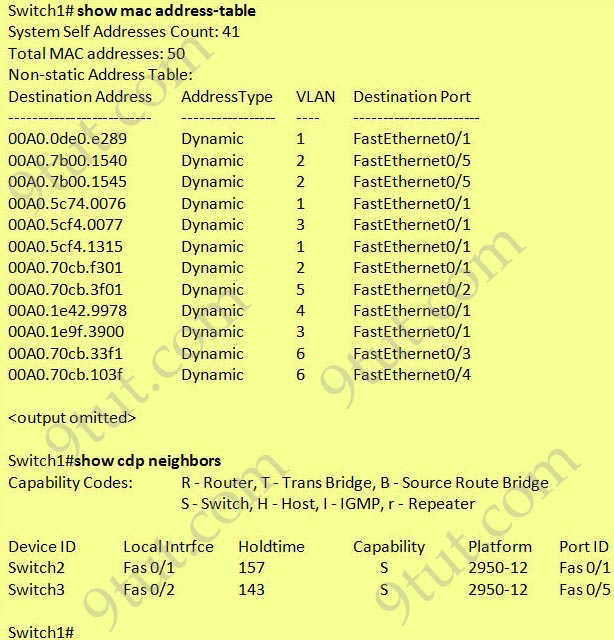
Which two statements are true of the interfaces on Switch1? (Choose two)
A. Interface FastEthernet0/2 has been disabled.
B. Multiple devices are connected directly to FastEthernet0/1.
C. FastEthernet0/1 is configured as a trunk link.
D. FastEthernet0/1 is connected to a host with multiple network interface cards
E. FastEthernet0/5 has statically assigned MAC addresses.
F. A hub is connected directly to FastEthernet0/5
Answer: C F
Explanation
FastEthernet0/1 can receive traffic from multiple VLANs -> it is configured as a trunk.
There are two MAC addresses learned from FastEthernet0/5 -> a hub is used on this port.
Question 10
The network administrator normally establishes a Telnet session with the switch from host A. The administrator’s attempt to establish a connect via Telnet to the switch from host B fails, but pings from host B to other two hosts are successful. What is the issue for this problem?
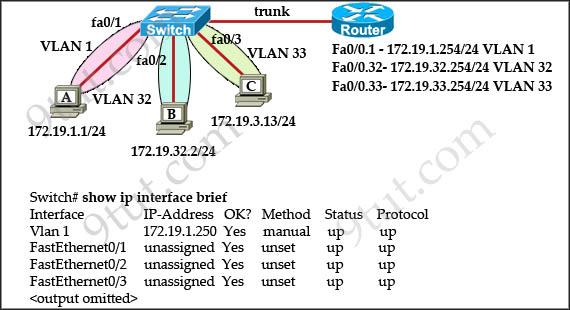
A. Host B and the switch need to be in the same subnet.
B. The switch needs an appropriate default gateway assigned.
C. The switch interface connected to the router is down.
D. Host B need to be assigned an IP address in vlan 1.
Answer: B
Explanation
Host A (172.19.1.1) and the management IP address of the Switch (172.19.1.250) are in the same subnet so telnet from host A to the switch can be successful even if a default gateway is not set on host A.
But host B (172.19.32.2) and the management IP address of the Switch (172.19.1.250) are not in the same subnet so host B needs a default gateway to telnet to the switch. The default gateway on host B should be 172.19.32.254.
Question 11
What does a Layer 2 switch use to decide where to forward a received frame?
A. source MAC address
B. source IP address
C. source switch port
D. destination IP address
E. destination port address
F. destination MAC address
Answer: F
Question 12
The network administrator cannot connect to Switch1 over a Telnet session, although the hosts attached to Switch1 can ping the interface Fa0/0 of the router. Given the information in the graphic and assuming that the router and Switch2 are configured properly, which of the following commands should be issued on Switch1 to correct this problem?
A. Switch1 (config)# line con0
Switch1 (config-line)# password cisco
Switch1 (config-line)#login
B. Switch1 (config)# interface fa0/1
Switch 1(config-if)# ip address 192.168.24.3 255.255.255.0
C. Switch1 (config)# ip default-gateway 192.168.24.1
D. Switch1 (config)# interface fa0/1
Switch 1(config-if)# duplex full
Switch 1(config-if)# speed 100
E. Switch1 (config)# interface fa0/1
Switch 1(config-if)# switchport mode trunk
Answer: C
Question 13
How many broadcast domains are shown in the graphic assuming only the default vlan is configured on the switches?
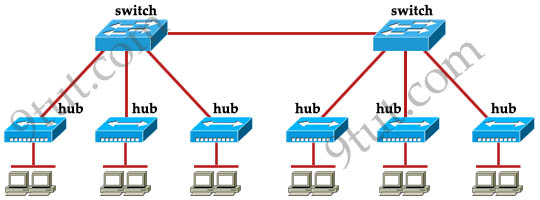
A. one
B. six
C. twelve
D. two
Answer: A
Explanation
Only router can break up broadcast domains but in this exhibit no router is used so there is only 1 broadcast domain.
For your information, there are 7 collision domains in this exhibit (6 collision domains between hubs & switches + 1 collision between the two switches).
Question 14
Refer to the exhibit. Which of these statements correctly describes the state of the switch once the boot process has been completed?
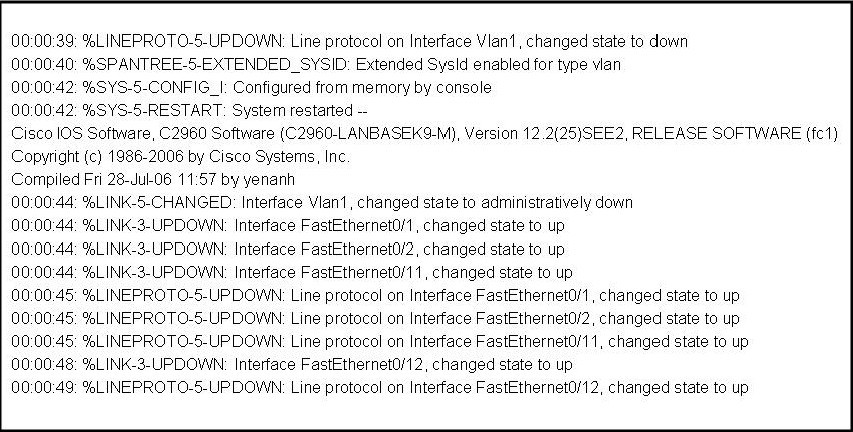
A. As FastEthernet0/12 will be the last to come up, it will not be blocked by STP.
B. Remote access management of this switch will not be possible without configuration change.
C. More VLANs will need to be created for this switch.
D. The switch will need a different IOS code in order to support VLANs and STP.
Answer: B
Explanation
From the output we notice that the administrator has just shut down Interface Vlan1, which is the default VLAN so no one can access it remotely (like telnet) -> B is correct.
Answer A is not correct as STP calculation does not depend on which port comes up first or last. STP recalculates when there is a change in the network.
A normal switch can operate without VLAN -> C is not correct.
This IOS does support VLAN because it has VLAN 1 on it -> D is not correct.
Refer to the exhibit.

Switch-1 needs to send data to a host with a MAC address of 00b0.d056.efa4. What will Switch-1 do with this data?
A. Switch-1 will drop the data because it does not have an entry for that MAC address.
B. Switch-1 will forward the data to its default gateway.
C. Switch-1 will flood the data out all of its ports except the port from which the data originated.
D. Switch-1 will send an ARP request out all its ports except the port from which the data originated.
Answer: C
Explanation
The MAC address of 00b0.d056.efa4 has not been learned in its MAC address table so Switch-1 will broadcast the frame out all of its ports except the port from which the data originated.
Question 2

A technician has installed SwitchB and needs to configure it for remote access from the management workstation connected SwitchA. Which set of commands is required to accomplish this task?
A.
SwitchB(config)#interface FastEthernet 0/1
SwitchB(config)#ip address 192.168.8.252 255.255.255.0
SwitchB(config)#no shutdown
B.
SwitchB(config)#ip default-gateway 192.168.8.254
SwitchB(config)#interface vlan 1
SwitchB(config)#ip address 192.168.8.252 255.255.255.0
SwitchB(config)#no shutdown
C.
SwitchB(config)#interface vlan 1
SwitchB(config)#ip address 192.168.8.252 255.255.255.0
SwitchB(config)#ip default-gateway 192.168.8.254 255.255.255.0
SwitchB(config)#no shutdown
D.
SwitchB(config)#ip default-network 192.168.8.254
SwitchB(config)#interface vlan 1
SwitchB(config)#ip address 192.168.8.252 255.255.255.0
SwitchB(config)#no shutdown
Answer: B
Explanation
To remote access to SwitchB, it must have a management IP address on a VLAN on that switch. Traditionally, we often use VLAN 1 as the management VLAN (but in fact it is not secure).
In the exhibit, we can recognize that the Management Workstation is in a different subnet from the SwitchB. For intersubnetwork communication to occur, you must configure at least one default gateway. This default gateway is used to forward traffic originating from the switch only, not to forward traffic sent by devices connected to the switch.
Question 3
A switch is configured with all ports assigned to vlan 2 with full duplex FastEthernet to segment existing departmental traffic. What is the effect of adding switch ports to a new VLAN on the switch?
A. More collision domains will be created.
B. IP address utilization will be more efficient.
C. More bandwidth will be required than was needed previously.
D. An additional broadcast domain will be created.
Answer: D
Question 4
Refer to the exhibit. The two connected ports on the switch are not turning orange or green. What would be the most effective steps to troubleshoot this physical layer problem? (Choose three)

A. Ensure that the Ethernet encapsulations match on the interconnected router and switch ports.
B. Ensure that cables A and B are straight-through cables.
C. Ensure cable A is plugged into a trunk port.
D. Ensure the switch has power.
E. Reboot all of the devices.
F. Reseat all cables.
Answer: B D F
Explanation
The ports on the switch are not up indicating it is a layer 1 (physical) problem so we should check cable type, power and how they are plugged in.
Question 5
Refer to the exhibit.

What two results would occur if the hub were to be replaced with a switch that is configured with one Ethernet VLAN? (Choose two)
A. The number of collision domains would remain the same.
B. The number of collision domains would decrease.
C. The number of collision domains would increase.
D. The number of broadcast domains would remain the same.
E. The number of broadcast domains would decrease.
F. The number of broadcast domains would increase.
Answer: C D
Question 6
Refer to the exhibit. Give this output for SwitchC, what should the network administrator’s next action be?

A. Check the trunk encapsulation mode for SwitchC’s fa0/1 port.
B. Check the duplex mode for SwitchC’s fa0/1 port.
C. Check the duplex mode for SwitchA’s fa0/2 port.
D. Check the trunk encapsulation mode for SwitchA’s fa0/2 port.
Answer: C
Question 7
Which three statements accurately describe layer 2 Ethernet switches? (choose three)
A. Microsegmentation decreases the number of collisions on the network.
B. If a switch receives a frame for an unknown destination.it uses ARP to resolve the address.
C. Spanning Tree Protocol allows switches to automatically share vlan information.
D. In a property functioning network with redundant switched paths, each switched segment will contain one root bridge with all its ports in the forwarding state. All other switches in that broadcast domain will have only one root port.
E. Establishing vlans increases the number of broadcast domains.
F. Switches that are configured with vlans make forwarding decisions based on both layer 2 and layer 3 address information.
Answer: A D E
Question 8
Why will a switch never learn a broadcast address?
A. Broadcast frames are never sent to switches.
B. Broadcast addresses use an incorrect format for the switching table.
C. A broadcast address will never be the source address of a frame.
D. Broadcasts only use network layer addressing.
E. A broadcast frame is never forwarded by a switch.
Answer: C
Question 9
Refer to the exhibit:

Which two statements are true of the interfaces on Switch1? (Choose two)
A. Interface FastEthernet0/2 has been disabled.
B. Multiple devices are connected directly to FastEthernet0/1.
C. FastEthernet0/1 is configured as a trunk link.
D. FastEthernet0/1 is connected to a host with multiple network interface cards
E. FastEthernet0/5 has statically assigned MAC addresses.
F. A hub is connected directly to FastEthernet0/5
Answer: C F
Explanation
FastEthernet0/1 can receive traffic from multiple VLANs -> it is configured as a trunk.
There are two MAC addresses learned from FastEthernet0/5 -> a hub is used on this port.
Question 10
The network administrator normally establishes a Telnet session with the switch from host A. The administrator’s attempt to establish a connect via Telnet to the switch from host B fails, but pings from host B to other two hosts are successful. What is the issue for this problem?

A. Host B and the switch need to be in the same subnet.
B. The switch needs an appropriate default gateway assigned.
C. The switch interface connected to the router is down.
D. Host B need to be assigned an IP address in vlan 1.
Answer: B
Explanation
Host A (172.19.1.1) and the management IP address of the Switch (172.19.1.250) are in the same subnet so telnet from host A to the switch can be successful even if a default gateway is not set on host A.
But host B (172.19.32.2) and the management IP address of the Switch (172.19.1.250) are not in the same subnet so host B needs a default gateway to telnet to the switch. The default gateway on host B should be 172.19.32.254.
Question 11
What does a Layer 2 switch use to decide where to forward a received frame?
A. source MAC address
B. source IP address
C. source switch port
D. destination IP address
E. destination port address
F. destination MAC address
Answer: F
Question 12
The network administrator cannot connect to Switch1 over a Telnet session, although the hosts attached to Switch1 can ping the interface Fa0/0 of the router. Given the information in the graphic and assuming that the router and Switch2 are configured properly, which of the following commands should be issued on Switch1 to correct this problem?
A. Switch1 (config)# line con0
Switch1 (config-line)# password cisco
Switch1 (config-line)#login
B. Switch1 (config)# interface fa0/1
Switch 1(config-if)# ip address 192.168.24.3 255.255.255.0
C. Switch1 (config)# ip default-gateway 192.168.24.1
D. Switch1 (config)# interface fa0/1
Switch 1(config-if)# duplex full
Switch 1(config-if)# speed 100
E. Switch1 (config)# interface fa0/1
Switch 1(config-if)# switchport mode trunk
Answer: C
Question 13
How many broadcast domains are shown in the graphic assuming only the default vlan is configured on the switches?

A. one
B. six
C. twelve
D. two
Answer: A
Explanation
Only router can break up broadcast domains but in this exhibit no router is used so there is only 1 broadcast domain.
For your information, there are 7 collision domains in this exhibit (6 collision domains between hubs & switches + 1 collision between the two switches).
Question 14
Refer to the exhibit. Which of these statements correctly describes the state of the switch once the boot process has been completed?

A. As FastEthernet0/12 will be the last to come up, it will not be blocked by STP.
B. Remote access management of this switch will not be possible without configuration change.
C. More VLANs will need to be created for this switch.
D. The switch will need a different IOS code in order to support VLANs and STP.
Answer: B
Explanation
From the output we notice that the administrator has just shut down Interface Vlan1, which is the default VLAN so no one can access it remotely (like telnet) -> B is correct.
Answer A is not correct as STP calculation does not depend on which port comes up first or last. STP recalculates when there is a change in the network.
A normal switch can operate without VLAN -> C is not correct.
This IOS does support VLAN because it has VLAN 1 on it -> D is not correct.